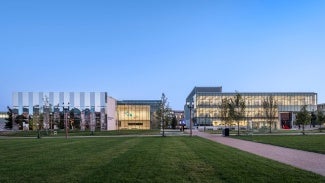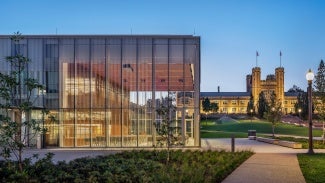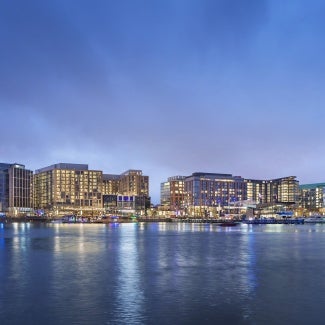East End Transformation
The award-winning regional and urban design for the East End Transformation at Washington University in St. Louis transforms a car-centric site into a welcoming and dynamic campus front door that emphasizes public use.

Project highlights: East End Transformation
- Architects: KieranTimberlake, Tao+Lee Associates, BNIM, Moore Ruble Yudell, Mackey Mitchel, Perkins Eastman, Patterhn Ives
- Owner: Washington University in St. Louis
- Location: St. Louis
Designed in 1900 by Cope and Stewardson, Washington University’s Danforth Campus in St. Louis was to be a park-like setting where collegiate gothic buildings, landscape quadrangles, and pathways worked in concert to prompt academic connections. However, in the intervening years, the campus’ east end became plagued with roads and parking lots, upending the original planning vision. This project transforms a car-centric site into a welcoming front door to a dynamic campus that emphasizes pedestrians and bicycles.
Each of the new buildings remains faithful to Cope and Stewardson’s original vision, yet they embody a vibrant contemporary approach to materials, technology, and sustainability. All were designed to achieve LEED Gold certification, with three achieving LEED Platinum. Sumers Welcome Center, which hosts the university’s undergraduate admissions and student financial services departments, is the very first stop on campus for visitors and prospective students. The glass-enclosed building offers sweeping views of the university’s compelling Brookings Hall. Directly across from the welcome center is the Schnuck Pavilion, which houses a café, bike hub, and the university’s office of sustainability.
Additional new buildings include Weil Hall, a new home for the Sam Fox School of Design and Visual Arts, which boasts flexible and naturally lit lofts that surround a digital fabrication studio and a light-filled central courtyard with a vibrant living wall. An expansion for the university’s Mildred Lane Kemper Art Museum, one of the oldest teaching museums in the country, has greatly increased exhibition space for outsized artworks and allows the museum to hang a greater portion of its world-class collection.
Beneath it all, natural light streams into the new underground parking garage, orienting visitors from their cars to their first steps on campus. In increasing access to the campus, the garage also promotes low-carbon transportation through electric vehicle charging stations, designated car-share parking, and a shuttle stop. Perhaps most importantly, the garage has been configured to support a post-private vehicle world. The floor-to-floor heights were increased, and live load capacities expanded beyond conventional design to accommodate a wide range of future academic uses.
Project team & jury
Landscape Architect: Michael Vergason Landscape Architects with Arbolope Studio
Engineer - Structural: KPFF Consulting Engineers, Inc.
Engineer - MEP: BuroHappold Engineering, with KAI Engineering
Engineer - Central Utilities MEP: McClure Engineering
Engineer - Civil: Cole
Engineer - Geotechnical: Geotechnology Inc.
Construction Manager: McCarthy Building Companies, Inc.
Lighting Designer: Fisher Marantz Stone
AV Consultant: The Sextant Group
Code Consultant: Code Consultants, Inc.
Façade Consultant: Eckersley O’Callaghan + Partners
Acoustics: Metropolitan Acoustics
Soils and Irrigation: Jeffrey L. Bruce & Company, LLC
Campus Mobility: Schulze + Grassov
Cost Estimator: The Capital Projects Group
Waterproofing: Wiss Janney Elstner Associates
Graphics: Kuhlmann Leavitt, Inc.
Specifications: Heller & Metzger
LEED Administration: Sustainable Design Consulting
FFE: Arcturis
Victor Buchholz, AIA, Chair, LPK, Memphis, Tenn.
Kotaro Nakamura, AIA, RNT Architects, San Diego
Marilys Nepomechie, FAIA, Florida International University, Miami
Vanessa Quirk, New York
Yuting Zhang, AIA, Gensler, Boston
A Regional & Urban Design Award recognizes the best in urban design, regional and city planning, and community development.
Five projects showcase 2023's best planning projects that account for the entire built environment, local culture, and available resources.











